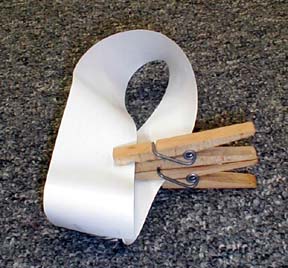
A Mobius collider holds a Mopbius strip ready for a
collision.

A Mobius collider holds a Mopbius strip ready for a
collision.
Introduction
Collide two twisted loops of paper and study the resulting combination particles.
Material
Assembly
Make the collider.
Hot melt glue the flat side of one clothes pin to the flat side of the other.
Make sure the clothes-grabbing ends both face the same way.
To Do and Notice
Make two Mobius strips. See the Mobius exploration.
Collide the Mobius strips.
To do this, grab the first Mobius strip in both jaws of the collider (the clothes pins.)
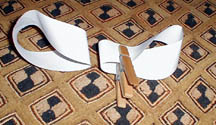
Two mobius strips, nose-to-nose, ready to collide.
Make the loop on one side of the collider have no half-twists.
Cut this loop.
Hold the second Mobius strip near the cut ends of the first one.
Cut the second Mobius strip.
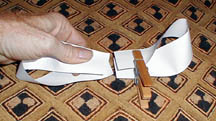
Cut the second mobius strip. Hold its ends next to the first
one.
Tape its free ends to the first one. This makes one loop.
Remove the Mobius strips from the collider.
Work the twists toward each other.
Notice what happens.
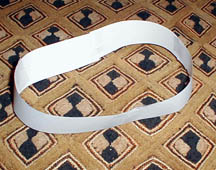
When these two mobius strips collide, their twists cancel and
a completely untwisted loop is formed.
There are two possible results: either nothing will happen,that is, the two twists will remain in the loop, or, the twists will come together and cancel each other so that no twists remain.
Before the collision each strip had a half-twist
and one side,
after the collision, one result has two sides and no twists
the other result has two sides and two half-twists.
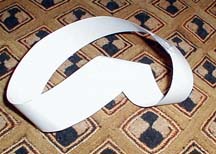
Another possible outcome of colliding two mobius strips is a
loop with two half twists.
Explore collisions between strips with different numbers of half-twists.
What happens when a Mobius strip with one
half-twist collides with a strip with two half twists. A one sided
object collides with a two sided object.
The result has how many sides? How many half-twists?
What's Going On?
Twists
There are right handed twists and left handed twists.
(To make a right-handed Mobius strip make the half-twist clockwise as you look at it then tape the loop together, to make a left-handed one, do everything the same but twist the strip counterclockwise.)
The number of half-twists before and after the collision can be made the same if right handed twists are counted as positive numbers then left handed twists are negative numbers.
Collide a right handed Mobius strip with a left handed one and you get a strip with no twists. +1 + -1 = 0.
Collide two right handed twists and you get one strip with two half twists, +1 + +1 = 2
Either of these results has two sides.
Sides
The rule for determining how many sides a loop has when it is made from the collision of two other loops. Is the same rule as the one for adding even and odd numbers.
Loops with odd numbers of half-twists have one
side,
those with 0 or even numbers have two sides.
Find the rule of how the sums of odd and even
numbers produce odd and even numbers.
odd+odd = even,
even + even = even,
odd +even = odd
Collide two strips with 1 half-twist each, the
resulting strip has 2 half-twists.
In the same way, the sum of two odd numbers is an even
number.
Collide a one sided strip with +1 half-twist with a two sided strip with +2 half-twists and you get a strip with +3 half-twists and one side.
Conservation of half-twists gives +1 + +2 = +3
In this collision, the number of sides were:
odd plus even equals odd
which translates into
one sides plus two sides equals one sided.
Going Further
A Mobius strip with +1 half-twist when collided with a Mobius strip with -1 half-twist produces a strip with no twists.
This models matter and antimatter.
When a particle of matter meets its antimatter particle they annihilate each other and neither particle remains after the collision.
|
Scientific Explorations with Paul Doherty |
|
1 October 2001 |